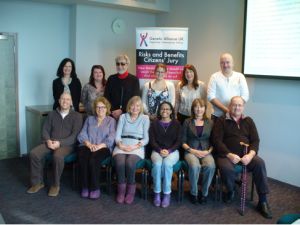Lorraine is the BUS fund-raiser and was diagnosed with Birdshot in September 2011. She was asked to tell her story to her local gym/club and they have published it on their web-site. Wonderful – not only does it help us raise the profile, and hopefully get some donations in for the Carrot Walk, but it also means that Birdshot stories are now speeding around the world. If anyone else can think of a way to get their stories into local or national media – please, please do.
Here is Lorraine

And here is the article Lorraine wrote for her local club:
I have been a member of the Park Club for over 5 years now and spend a huge amount of time in the adult bar and restaurant…I mean the gym!! The club has become such a big part of my family’s life over that period and never more so than now.
Last September I was diagnosed with an incurable eye disease called Birdshot Chorioretinopathy. This is a very rare and potentially blinding form of posterior uveitis which has a profound effect on your eyesight. It has changed my sight and my life in many ways over the last few months. I had pretty good vision up until June 2011 and then, within a few short months, I was unable to see well enough to cross the road safely on my own.
Birdshot is a very strange disease, it is quite mysterious and its progress and outcome vary enormously with every patient. It is often misdiagnosed and I feel really lucky that I live near an amazing hospital like Moorfields which has become my second home (after the Park Club!). The treatment for Birdshot is basically a lot of very toxic medication. I take more tablets now than I ever thought physically possible…I had to get over my tablet-taking phobia very quickly with this illness! I take very high doses of steroids and immunosuppressant drugs to control the inflammation in my eyes and to shut down my immune system. This, hopefully, will help to preserve my eyesight.
Since I started taking all these drugs I’ve seen some improvement in my vision and although I had a relapse in January I think I am making progress. This is something that unfortunately isn’t going to go away but will be part of my life forever. I’m trying to spend more time in the gym and doing classes because it’s really important to keep fit and strong when you are taking these kinds of drugs.
I’ve also become involved with The Birdshot Uveitis Society who have helped me a lot. In September I am taking part in the London Carrots Nightwalk for Fight For Sight. The aim of the walk is to raise money for a Birdshot Biobank to help fund research into this disease. I believe this is where the answers will lie. We need to find out why people get this eye condition and what can be done to treat it in a more effective way.
We are quite a rare group, us “Birdshotters” and our numbers are small. A Birdshot Biobank would really aid researchers and scientists interested in finding out more about the condition and would also help with devising better treatment options for sufferers.
Some fantastic friends from the Park Club are joining me on this walk and I think we will make a difference to the outcome for people like me. If you feel able to join us on our walk or to donate to this very personal cause, I would be so grateful! You can donate via my JustGiving page at http://www.justgiving.com/Lorraine-O-Mullane
Thanks for taking the time to read my essay!
Lorraine

